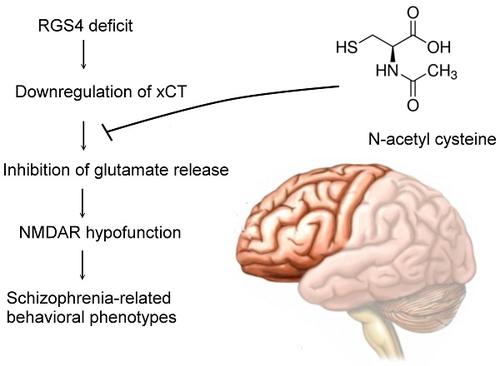Theranostics ( IF 12.4 ) Pub Date : 2018-09-09 , DOI: 10.7150/thno.25189 Min-Wei Huang , Yu-Jung Lin , Chi-Wei Chang , Fu-Ju Lei , En-Peng Ho , Ren-Shyan Liu , Woei-Cherng Shyu , Chia-Hung Hsieh

|
Rationale: Although molecular investigations of regulator of G-protein signaling 4 (RGS4) alterations in schizophrenia patients yielded partially inconsistent findings, the previous studies suggested that RGS4 is both a positional and functional candidate gene for schizophrenia and is significantly decreased in the prefrontal cortex. However, the exact role of RGS4 in the pathophysiology of schizophrenia is unclear. Moreover, a whole genome transcription profile study showed the possibility of RGS4-regulated expression of SLC7A11(xCT), a component of cysteine/glutamate transporter or system xc-. We hypothesized that system xc- is a therapeutic target of RGS4 deficit-mediated schizophrenia.
Methods: Pharmacological and genetic manipulation of RGS4 in organotypic brain slice cultures were used as an ex vivo model to investigate its role in system xc- and glutamatergic function. Lentiviral-based mouse models with RGS4 deficit in the prefrontal cortex and treatment with system xc- activator, N-acetyl cysteine (NAC), were utilized to observe their impacts on glutamatergic function and schizophrenic behaviors.
Results: Genetic and pharmacological inhibition of RGS4 resulted in a significant decrease in SLC7A11 (xCT) expression and hypofunction of system xc- and reduced glutamatergic function in organotypic brain slice cultures. However, NAC restored the dysregulation of RGS4-mediated functional deficits of glutamate. Moreover, knockdown of RGS4 specifically in the prefrontal cortex caused mice to exhibit behaviors related to schizophrenia such as increased stereotypy, impaired prepulse inhibition, deficits in social interactions, working memory, and nesting behavior, while enhancing sensitivity to the locomotor stimulatory effect of MK-801. These mice displayed glutamatergic dysfunction in the prefrontal cortex, which may have contributed to the behavioral deficits. RGS4 knockdown mice that received NAC treatment had improved glutamatergic dysfunction and schizophrenia behaviors.
Conclusion: Our results suggest that RGS4 deficit induces dysregulation and dysfunction of system xc-, which further results in functional deficits of the glutamatergic system and subsequently to schizophrenia-related behavioral phenotypes. Activation of system xc- offers a promising strategy to treat RGS4 deficit-mediated schizophrenia.
Keywords: regulator of G-protein signaling 4, system xc-, schizophrenia, glutamatergic transmission, N-acetyl cysteine
中文翻译:

RGS4赤字前额叶皮层有助于通过系统X与精神分裂症有关的行为Ç -小鼠介导的谷氨酸功能障碍
理由:尽管对精神分裂症患者中G蛋白信号4(RGS4)调节因子的分子研究发现部分不一致的发现,但先前的研究表明RGS4既是精神分裂症的定位基因又是功能候选基因,在额叶前额皮层中显着降低。但是,RGS4在精神分裂症的病理生理中的确切作用尚不清楚。此外,全基因组转录概况的研究表明SLC7A11(XCT)的RGS4调节的表达的可能性,半胱氨酸/谷氨酸转运或系统x的分量Ç - 。我们假设系统X Ç -是RGS4赤字介导精神分裂症的治疗靶点。
方法:药理学和器官型脑切片文化RGS4的遗传操作被用来作为一种体外模型来研究它在系统X作用Ç -与谷氨酸功能。在前额皮质和治疗与系x RGS4赤字基于慢病毒的小鼠模型Ç -活化剂,N-乙酰半胱氨酸(NAC),被利用来观察它们对谷氨酸功能和精神分裂症的行为的影响。
结果: RGS4的遗传和药理抑制作用导致SLC7A11(xCT)的表达显着降低,并且系统x c的功能减退-并降低器官型脑切片培养物中的谷氨酸能功能。但是,NAC恢复了RGS4介导的谷氨酸功能缺陷的失调。此外,特别是在前额叶皮层中敲低RGS4可使小鼠表现出与精神分裂症有关的行为,例如增加刻板印象,削弱前冲抑制,社交互动不足,工作记忆和筑巢行为,同时增强了对MK-的运动刺激作用的敏感性。 801。这些小鼠在前额叶皮层中表现出谷氨酸能功能障碍,这可能是行为缺陷的原因。接受NAC治疗的RGS4敲低小鼠具有改善的谷氨酸能功能障碍和精神分裂症行为。
结论:我们的研究结果表明RGS4赤字诱导失调及系统的功能障碍X Ç - ,这进一步导致谷氨酸能系统的功能障碍,并随后与精神分裂症有关的行为表型。系统x c的激活-为治疗RGS4缺陷介导的精神分裂症提供了一种有希望的策略。
关键词:G蛋白的调节器4的信号,系x Ç - ,精神分裂症,谷氨酸能传递,N-乙酰半胱氨酸











































 京公网安备 11010802027423号
京公网安备 11010802027423号